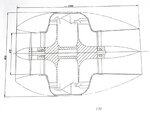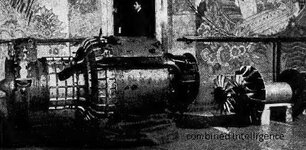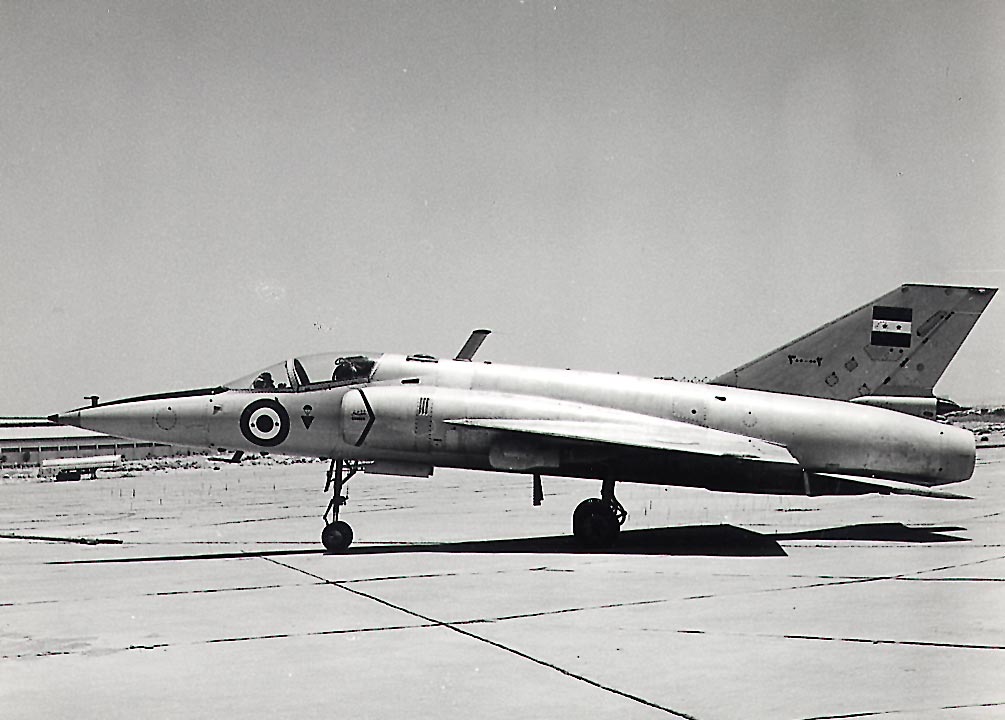kool kitty89
Senior Master Sergeant
OK so I took a look in my copy of "Hans Von Ohain: Elegance In Flight" and on page 263, it has a cut-away diagram of the HeS3b as part of the display reconstructions made for the Smithsonian and Deutsches Museum of Munich, and the following figures are included:
diameters
housing: 41.5 in
compressor rotor: 25.2 in
turbine rotor: 24.2 in
length: 41.25 in
speed: 11,500 rpm
thrust: 1100 lb
weight: 800 lb
and on pg 270
He S3b
thrust: 989 lbs (4400 N)
pressure ratio 2.8:1
sfc: 1.6 lb/lbf/hr
turbine inlet temp: 690C
RPM 13000
diameter 1.054 m
weight: 360 kg
he s8A
thrust: 1124 lbs (5000 N)
pressure ratio 2.7:1
sfc: 1.82 lb/lbf/hr
turbine inlet temp: 700C
RPM 13500
diameter .782 m
weight: 380 kg
(edit: Mar 7, 2022, fixed units: on closer inspection, several "mm" labels were actually "in")
No mention is made on the HeS 6, and there's no mention of it in the index either, so no info there and no confirmation on whether the drawing listed elsewhere as the HeS 6 is actually such. (the high specific fuel consumption of the HeS 8A is interesting though, and makes some sense given the poorer pressure ratio)
However, this page has some interesting info, including some of Heinkel's piston engine ducted fan developments:
Google Translate (original is spanish)
Now, with the 782 mm HeS 8a diameter figure assumed correct, and the diagrams of the HeS 8 are to scale, then the compressor rotor must be smaller than the 640 mm (25.2 in) of the HeS 3b, approximately 590 mm or 23.2 inches by my measurement. And assuming the claimed HeS 6 diagram is also accurate, and uses that same impeller, the overall diameter of that engine would be about 1170 mm or 46.1 inches. (and if the HeS 8A was directly based on the HeS 6 compressor/turbine, it's possible the HeS 6 was dismantled and cannibalized for those and some other components to be re-used in the first HeS 8 prototype; the same may have been true for the HeS 3a to 3b transition)
If the 590 kp 1300 lbf thrust figure for the HeS 6 is accurate, and 13300 rpm, then it's fair to assume the much larger diffuser and combustion chamber (proportionally larger than the HeS 3b's as well) contributed to greater compressor and combustion efficiency. (between the experimental nature of the axial diffuser, relatively short area for diffusion and expansion in the combustion chamber, and relatively small area for the flame tubes and combustion/mixing in the HeS 8 this is also not too hard to believe)
The operating RPM of various engines seems somewhat in question, though the 11500 on that one drawing of the HeS 3b may refer to its initial operating maximum, or possibly the restricted maximum for installed flight testing: this latter point would make some sense given the same sort of restrictions placed on bench vs flight thrust on other prototype engines. The Halford H.1 being a great example of many stages of increased thrust and various values being noted and spit out in different articles, confusing its performance: 1,500, 2,000, 2,100, 2,300, 2,460, and 3,000 lb thrust all being cited in different contexts, but the context isn't always given: Joe Baugher lists 2,460 lb at 9500 RPM for installed flight thrust in the XP-80, with bench thrust being 3,000 lb at 10,500 RPM, meanwhile the production Goblin I was rated for 2,700 lb at 10,000 RPM: also note thrust being about proportional to the square of the RPM, which I assume is related to the nature of centrifugal flow compressors) The drawing citing 1100 lb thrust (corresponding to the 500 kp figure sometimes cited elsewhere) being matched to the lower RPM figure and 13,000 being matched to 989 lbs in the chart also seems a bit odd, though. (there's no context given to either of those figures, so they might be mismatched or dependent on other factors)
Though if my previous assumptions are correct, and the 13000 RPM and 13300 rpm figures are also correct for the HeS 3 and HeS 6, that would further indicate improved compressor and combustion efficiency in the latter. (though if the overall pressure ratio was still 2.8:1 and turbine inlet temperatures were similar, the specific fuel consumption might not have changed much/at all, and the 'efficiency' gain would be on reduced impeller and turbine tip speeds, reduced centrifugal and creep loads, and reduced stresses on the engine components) OTOH, it may have improved fuel consumption, too as some sources claim, but I have no additional info there, just contradicting claims.
Meanwhile, an image in this thread seems to be the origins of the 930 mm (0.93 meter) diameter figure:
Motores de aviación alemanes, S.G.M.
Google Translate
Photobucket
There's also a diagram of the HeS 2 and good photos of Ohain and Hann's 'garage engine' that didn't self-sustain (built prior to joining Heinkel) on that page, and the images appear to be taken from:
TURBOJET History and Development 1930-1960 Volume 1 Great Britain and Germany
Antony L. Kay
The Crowood press
I'm not sure all the photos in there are taken from that book or not, it's not totally clear, though the HeS 6 image further down seems to be a digital copy of the one from the Origins of German Jet Power site.
Oddly it also mentions:
I've never seen the HeS 6 referred to as the 109-001, only the HeS 8 being referred to as receiving that designation.
Google Translate
Heinkel
Interesting info there, though I can't translate the PDF, but I can make out the technical data portions at least. (though the HeS 011's diameter seems quite large at 1080 mm, in fact that's close to the figure I got when fiddling around with scaled-up HeS 8 dimensions, based on the 782 mm diameter and assumption of a 590 mm compressor impeller, scaling up to a Halford Goblin sized 32 inch impeller)
The translated excerpt mentions the HeS 1 producing 249 kp thrust, HeS 3b producing 498 kp thrust, the HeS 6 producing 589 kp and HeS 30 producing 860 kp with a weight of 388 kg.
Google Translate info on a bunch of early other jet engine designs from around the world there, too
Edit: attached images of what should be a diagram of the HeS2 (at 970 mm diameter) and the mystery, possibly HeS 3 diagram listing the 930 figure.
diameters
housing: 41.5 in
compressor rotor: 25.2 in
turbine rotor: 24.2 in
length: 41.25 in
speed: 11,500 rpm
thrust: 1100 lb
weight: 800 lb
and on pg 270
He S3b
thrust: 989 lbs (4400 N)
pressure ratio 2.8:1
sfc: 1.6 lb/lbf/hr
turbine inlet temp: 690C
RPM 13000
diameter 1.054 m
weight: 360 kg
he s8A
thrust: 1124 lbs (5000 N)
pressure ratio 2.7:1
sfc: 1.82 lb/lbf/hr
turbine inlet temp: 700C
RPM 13500
diameter .782 m
weight: 380 kg
(edit: Mar 7, 2022, fixed units: on closer inspection, several "mm" labels were actually "in")
No mention is made on the HeS 6, and there's no mention of it in the index either, so no info there and no confirmation on whether the drawing listed elsewhere as the HeS 6 is actually such. (the high specific fuel consumption of the HeS 8A is interesting though, and makes some sense given the poorer pressure ratio)
However, this page has some interesting info, including some of Heinkel's piston engine ducted fan developments:
Google Translate (original is spanish)
Now, with the 782 mm HeS 8a diameter figure assumed correct, and the diagrams of the HeS 8 are to scale, then the compressor rotor must be smaller than the 640 mm (25.2 in) of the HeS 3b, approximately 590 mm or 23.2 inches by my measurement. And assuming the claimed HeS 6 diagram is also accurate, and uses that same impeller, the overall diameter of that engine would be about 1170 mm or 46.1 inches. (and if the HeS 8A was directly based on the HeS 6 compressor/turbine, it's possible the HeS 6 was dismantled and cannibalized for those and some other components to be re-used in the first HeS 8 prototype; the same may have been true for the HeS 3a to 3b transition)
If the 590 kp 1300 lbf thrust figure for the HeS 6 is accurate, and 13300 rpm, then it's fair to assume the much larger diffuser and combustion chamber (proportionally larger than the HeS 3b's as well) contributed to greater compressor and combustion efficiency. (between the experimental nature of the axial diffuser, relatively short area for diffusion and expansion in the combustion chamber, and relatively small area for the flame tubes and combustion/mixing in the HeS 8 this is also not too hard to believe)
The operating RPM of various engines seems somewhat in question, though the 11500 on that one drawing of the HeS 3b may refer to its initial operating maximum, or possibly the restricted maximum for installed flight testing: this latter point would make some sense given the same sort of restrictions placed on bench vs flight thrust on other prototype engines. The Halford H.1 being a great example of many stages of increased thrust and various values being noted and spit out in different articles, confusing its performance: 1,500, 2,000, 2,100, 2,300, 2,460, and 3,000 lb thrust all being cited in different contexts, but the context isn't always given: Joe Baugher lists 2,460 lb at 9500 RPM for installed flight thrust in the XP-80, with bench thrust being 3,000 lb at 10,500 RPM, meanwhile the production Goblin I was rated for 2,700 lb at 10,000 RPM: also note thrust being about proportional to the square of the RPM, which I assume is related to the nature of centrifugal flow compressors) The drawing citing 1100 lb thrust (corresponding to the 500 kp figure sometimes cited elsewhere) being matched to the lower RPM figure and 13,000 being matched to 989 lbs in the chart also seems a bit odd, though. (there's no context given to either of those figures, so they might be mismatched or dependent on other factors)
Though if my previous assumptions are correct, and the 13000 RPM and 13300 rpm figures are also correct for the HeS 3 and HeS 6, that would further indicate improved compressor and combustion efficiency in the latter. (though if the overall pressure ratio was still 2.8:1 and turbine inlet temperatures were similar, the specific fuel consumption might not have changed much/at all, and the 'efficiency' gain would be on reduced impeller and turbine tip speeds, reduced centrifugal and creep loads, and reduced stresses on the engine components) OTOH, it may have improved fuel consumption, too as some sources claim, but I have no additional info there, just contradicting claims.
Meanwhile, an image in this thread seems to be the origins of the 930 mm (0.93 meter) diameter figure:
Motores de aviación alemanes, S.G.M.
Google Translate
Photobucket
There's also a diagram of the HeS 2 and good photos of Ohain and Hann's 'garage engine' that didn't self-sustain (built prior to joining Heinkel) on that page, and the images appear to be taken from:
TURBOJET History and Development 1930-1960 Volume 1 Great Britain and Germany
Antony L. Kay
The Crowood press
I'm not sure all the photos in there are taken from that book or not, it's not totally clear, though the HeS 6 image further down seems to be a digital copy of the one from the Origins of German Jet Power site.
Oddly it also mentions:
HeS 6, on the other hand, evolution and modification of HeS 3B; it reached the thrust of 550 kp at 13,300 rpm and a weight of 420kg. The consumption compared to its predecessor was greatly improved, as well as reliability. The HeS 6 was tested under a He 111 before the end of the year. But the work stopped there, because they went to a new production model, the HeS 8, which was to propel the He 280.
The HeS 6 , was the first turbojet to receive an official name of the RLM, the 109-001 (109 is the prefix assigned to turbojets, in general, and the HeS 6 in particular was 001).
This is apparently a graph corresponding to HeS 6 ( 109-001 )
I've never seen the HeS 6 referred to as the 109-001, only the HeS 8 being referred to as receiving that designation.
Google Translate
Heinkel
Interesting info there, though I can't translate the PDF, but I can make out the technical data portions at least. (though the HeS 011's diameter seems quite large at 1080 mm, in fact that's close to the figure I got when fiddling around with scaled-up HeS 8 dimensions, based on the 782 mm diameter and assumption of a 590 mm compressor impeller, scaling up to a Halford Goblin sized 32 inch impeller)
The translated excerpt mentions the HeS 1 producing 249 kp thrust, HeS 3b producing 498 kp thrust, the HeS 6 producing 589 kp and HeS 30 producing 860 kp with a weight of 388 kg.
Google Translate info on a bunch of early other jet engine designs from around the world there, too
Edit: attached images of what should be a diagram of the HeS2 (at 970 mm diameter) and the mystery, possibly HeS 3 diagram listing the 930 figure.
Attachments
Last edited:





